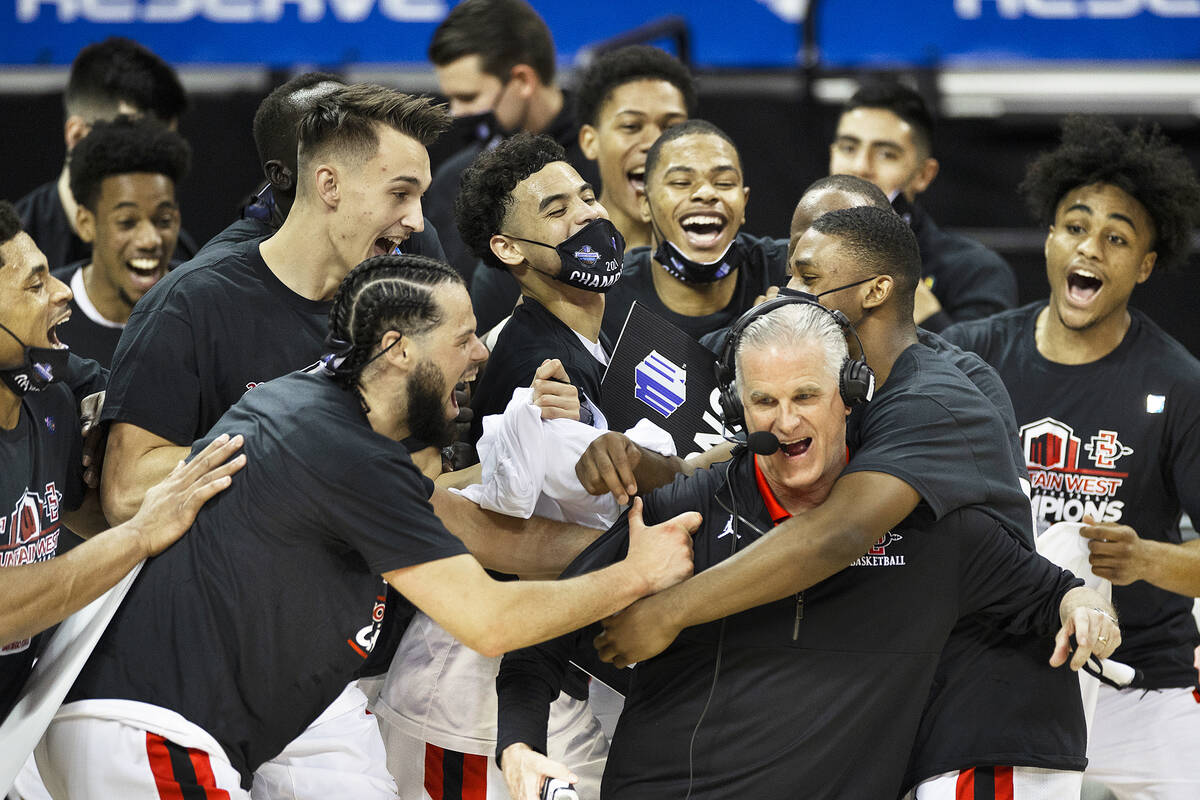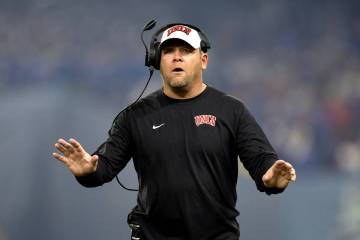Mountain West fights off poachers, stands pat for now
In a season of change in college sports, the Mountain West is maintaining the status quo, at least for the time being.
The American Athletic Conference targeted four MW schools as potential additions. But its plan didn’t work.
Air Force, Boise State, Colorado State and San Diego State all decided to stay in the Mountain West, leaving the American scrambling and the MW in position to credibly argue it is the nation’s top Group of Five conference.
“I don’t know if (the AAC sees) us as the biggest threat, but their commissioner was quoted as saying, ‘We hope to be even stronger than we are now,’” Mountain West Commissioner Craig Thompson said even before those schools decided to stay. “And they’re looking at Mountain West schools? Then that answers that question.”
The Mountain West’s board of directors, comprised of the university presidents, issued a statement Friday morning calling itself “the nation’s top Non-Autonomy Five conference” in a little bit of a victory lap after news broke it was staying together.
“The success and positive trajectories of our respective members have created opportunities for many of our universities, yet we collectively believe in the strength and shared spirit of the Mountain West and in the future possibilities for our conference,” the statement read.
“Close collaboration will continue as we identify the best path forward for the Mountain West within the evolving landscape of intercollegiate athletics. That will include aggressively pursuing strategic initiatives and amplifying our collective brand.”
UNLV interim athletic director Erick Harper said the focus is on doing what’s necessary to strengthen the Mountain West.
“We’re confident in the Mountain West’s ability to identify opportunities and best position the (conference) for the future,” Harper said. “Continuous change is always there. We just stick to what we know as the Mountain West and build what is best for our conference.”
Change coming
This isn’t to say the Mountain West shouldn’t have concerns about its future.
The Southeastern Conference started the current realignment cycle, taking Texas and Oklahoma from the Big 12 two months ago. The Big 12 then added AAC schools Central Florida, Cincinnati and Houston plus independent Brigham Young.
That prompted the American to counter by going after those four Mountain West schools, but Boise State and San Diego State quickly decided to remain in the conference. Air Force and Colorado State appeared on the way out, but each received significant pushback by supporters and media and opted to stay as well.
Losing all four schools would have dropped the Mountain West behind the AAC, but now both are at least on similar footing among the Group of Five leagues, which also includes Conference USA, the Mid-American and the Sun Belt. The Mountain West, in fact, should be in an even stronger position.
But the AAC hasn’t been the Mountain West’s only concern.
The Power Five leagues — which consist of the Atlantic Coast Conference, Big Ten, Big 12, Pac-12 and SEC — could continue to flex their muscle and negatively impact the Group of Five schools.
The recent handshake agreement for scheduling and mutual benefit among the Pac-12, ACC and Big Ten is an indication that opportunities will only continue to decrease for Group of Five conferences, leading to an increasing chasm that could result in an actual separation between the Power Five and G5 schools.
The NCAA meets in November to discuss potentially dramatic changes that would be decided at its January convention.
“I think there are future changes coming to the structure of collegiate athletics,” said AJ Maestas, founder of Navigate, a major sports business consultancy that provides financial guidance to sports and entertainment clients. “If you look just a little down the line, I think there are a bunch of reasons why (Mountain West officials) should not be content or unprepared right now.”
A lot of the preparation is for the unknown, and few understand that better than Jim Livengood, a former longtime UNLV and Pac-12 athletic director.
“None of us know what the next year, 18 months, 24 months is going to be like,” Livengood said. “It’s a crapshoot at best.”
The P5s separate
Though it was widely mocked because no agreements were signed, the alignment involving the ACC, Big Ten and Pac-12 was a step toward the power conferences further separating themselves. Those leagues committed to scheduling against each other, especially after current game contracts are fulfilled.
What that means to the Mountain West and other Group of Five leagues is fewer opportunities to play their big brothers. In other words, more UNLV games against Texas-San Antonio and fewer against Michigan or even Iowa State.
One major advantage the Mountain West has over its G5 brethren is geography. The MW and Pac-12 are the only major Western conferences that play football, and it could be in the Pac-12’s interest to establish a sort of mini alliance with the MW.
“I don’t know if they would listen, but I think it’s a very smart idea,” Maestas said.
In other sports, such as men’s basketball, the major conferences are still likely to need games against leagues such as the Mountain West to fill out their lengthy schedules. But the trend in recent years is to increase the number of conference games, meaning fewer opportunities for such matchups.
Traditional basketball powers with attractive cities such as UNLV and San Diego State probably will still be able to schedule marquee games, including home-and-home series that most other Group of Five schools have a difficult time landing. But even those two schools are more likely than not to find such opportunities fewer as the power conferences move toward a more exclusive arrangement of playing each other.
“I think this goes back to the larger question of what’s going to happen to the NCAA as a whole,” San Diego State athletic director John David Wicker said. “It will be interesting to see how all that plays out in the coming years.”
The bottom line
Future Power Five TV deals will “roughly doubling,” Maestas said, noting that some recent Group of Five contracts actually lost value.
Conferences could continue to position themselves when the next TV contracts are up for negotiation. The Big Ten’s contract expires in 2023, the Pac-12 in 2024, the Big 12 in 2025 and the Mountain West in 2026. The College Football Playoff deal also is up in 2026.
“Generally, conversations and membership changes and movement come about when TV contracts expire,” Thompson said.
Which could touch off another round of realignment, and this time instead of the AAC calling, it’s the Big 12 or Pac-12 going after Mountain West teams. Given the disparity in TV contracts, any Mountain West school with such an invitation wouldn’t hesitate to leave.
So the Mountain West will need to be proactive and consider its options should future change occur.
The conference could dip into the Eastern and Central time zones. Wicker said there’s an argument to be made that such a move would increase the conference’s national profile since league games now begin so late in that half of the country. “It’s something we’ve been looking at,” Wicker said.
A prominent basketball program in the West or even Midwest could be added to get to 12 in that sport. The Mountain West went after Gonzaga in 2018, but the West Coast Conference responded by meeting the Bulldogs’ requests (demands?) to keep them.
If the Mountain West could get Gonzaga or a program of its caliber, the conference probably would do so. But there is little appetite among its schools to offer anything beyond what all members receive. Some hard feelings remain from the deal the conference gave Boise State in 2012 when it appeared headed to the Big East.
“Often times you create unnecessary problems,” Thompson said.
Thompson said beyond what the conference membership might look like, discussions within the league have centered on abolishing the two football divisions and playing a championship game between the top two teams. The number of conference football games also could go from eight to nine.
Serious questions will be asked at all Group of Five conferences over the next several years as the national college sports landscape continues to evolve.
Questions, at this point, with no easy answers.
Contact reporter Mark Anderson at manderson@reviewjournal.com. Follow @markanderson65 on Twitter.































